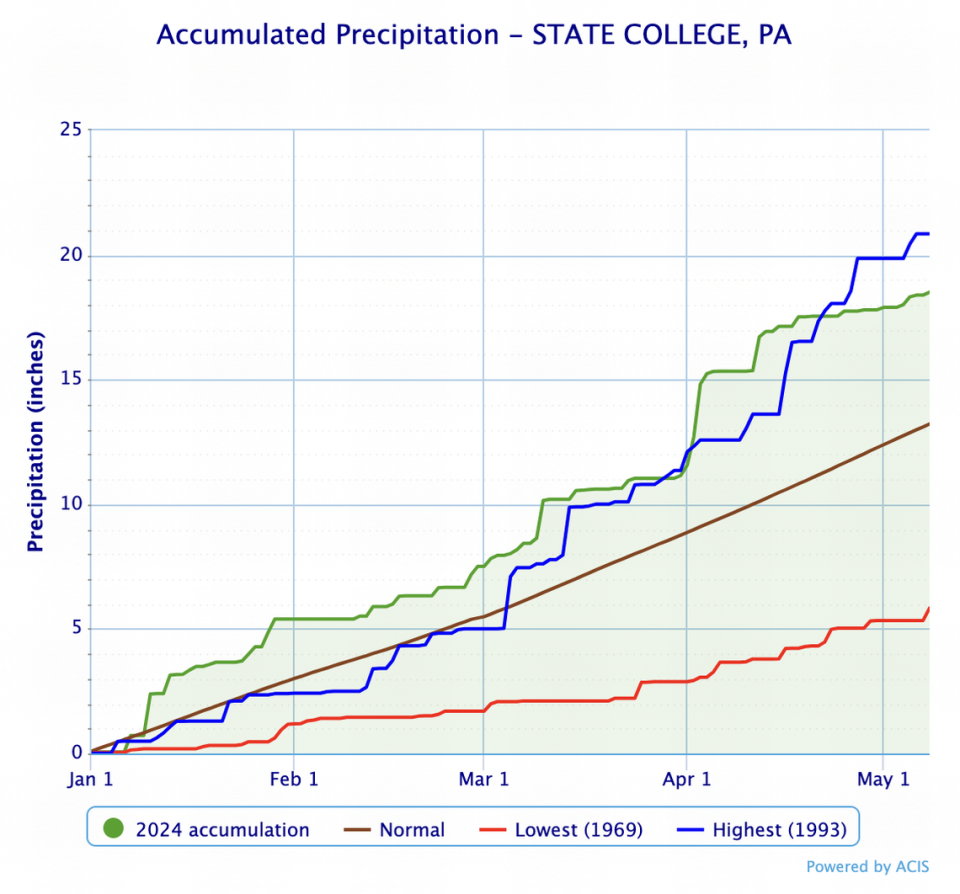Will central Pennsylvania see the ‘sultry, soggy’ summer the Farmers’ Almanac predicts?
Although a mild winter gave way to a particularly wet spring, State College and central Pennsylvania could be in for a warm and muggy summer.
The Keystone State has between roughly a 50 and 60% chance of observing above-average temperatures in May, June and July, according to the latest models from the National Weather Service’s Climate Prediction Center. The chances for above-average precipitation in those three months are lower for much of Pennsylvania, where the likelihood is around 33 to 40% for the southern half of the commonwealth. An equal chance of above- and below-normal precipitation is expected for the northern half of Pennsylvania, the agency predicts.
So, what might this summer look like for Pennsylvania? Here’s what to know, including predictions from the Farmers’ Almanac and historical data from the NWS.
What does the Farmers’ Almanac predict for summer 2024?
Most of the U.S. will see a particularly warm and wet summer this year, the Farmers’ Almanac predicts. Northwestern states are most likely to observe more dry days and more typical temperatures for the season.
Pennsylvania and many northeastern states are expected to encounter a “sultry, soggy” summer, the Farmers’ Almanac predicts. Regular storms and showers are expected for much of the eastern and southern parts of the country, while California and much of the West Coast can look forward to hot temperatures, but largely dry conditions.
Heading into August and September, the eastern two-thirds of the country can likely expect wet and showery conditions, according to the almanac. Continued rain might produce a particularly bothersome season thanks to bug populations that thrive in wetter weather, including mosquitoes, stink bugs and termites.
A summer bringing above-average rainfall would help continue what has already been a particularly wet year for the Centre County area. Between Jan. 1 and May 8, State College received approximately 18.5 inches of precipitation, falling just shy of the all-time record for that period, 20.85 inches, set in 1993. The near-record rainfall likely came under the influence of the outgoing El Niño climate pattern, which can influence weather by altering trade winds.

The summer season officially begins Thursday, June 20 on the summer solstice, which offers the longest period of daylight and the shortest night of the year. This solstice marks the earliest start to the season in 128 years, the Farmers’ Almanac says.
The almanac develops its predictions using a secret formula that considers a number of natural factors and phenomena, including planetary positioning, tidal action from the moon and sunspot activity. The only person said to know the Farmers’ Almanac’s formula is a weather prognosticator who uses a pseudonym.
“To safeguard this valuable formula, the editors of the Farmers’ Almanac keep its weather prognosticator — Caleb Weatherbee — identity and the exact formula as brand secrets,” the almanac wrote on its website.
What is an average summer like in State College?
The NWS tracks climate normals and averages for notable areas across the country, including State College. Here’s what you can expect in June, July and August, according to NWS data from 1991 to 2020.
State College in June:
Average minimum temperature: 59.3 degrees Fahrenheit
Average maximum temperature: 77 degrees
Average overall temperature: 68.1 degrees
Total normal precipitation: 4.09 inches
State College in July:
Average minimum temperature: 63.3 degrees
Average maximum temperature: 81.1 degrees
Average overall temperature: 72.2 degrees
Total normal precipitation: 3.79 inches
State College in August:
Average minimum temperature: 61.6 degrees
Average maximum temperature: 79.3 degrees
Average overall temperature: 70.4 degrees
Total normal precipitation: 4.16 inches
Roughly 16.9 inches of precipitation fell in State College in June, July and August last summer, according to NWS records. Central Pennsylvania observed slight drought conditions in the late spring and early summer of 2023.

